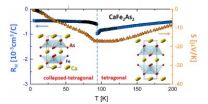(Press-News.org) In the largest family study on autism spectrum disorder (ASD) to date, researchers from the Icahn School of Medicine at Mount Sinai, along with a research team from the Karolinska Institutet in Stockholm Sweden and King's College in London found that individual risk of ASD and autistic disorder increased with greater genetic relatedness in families – that is, persons with a sibling, half-sibling or cousin diagnosed with autism have an increased likelihood of developing ASD themselves. Furthermore, the research findings showed that "environmental" factors unique to the individual (birth complications, maternal infections, etc.) were more of a determinant for ASD than previously believed.
The population-based, longitudinal study, titled "The Familial Risk of Autism," was led by Abraham Reichenberg, PhD, Professor of Psychiatry and Preventive Medicine at the Icahn School of Medicine at Mount Sinai, and was first published online in the Journal of the American Medical Association.
"The findings from this extensive, prospective study will help improve how we counsel families with children who suffer from ASD and autistic disorder," said Dr. Reichenberg. "Currently, ASD affects nearly one percent of all children born in the United States. This study tells us that while we continue to study the genetic risk factors associated with ASD, we should find what environmental factors may play a role as well."
ASD is defined as impairment in social interaction and communication and the presence of restricted interests and repetitive behaviors; in the U.S., approximately one percent of the population is believed to have ASD. For purposes of this study, ASD included the definition for Asperger syndrome.
The study cohort comprised more than two million Swedish children born in 1982 through 2006, and included more than 1.6 million unique families. The breadth of this study allowed researchers the opportunity to examine a large spectrum of relatedness, including monozygotic (identical) and dizygotic (fraternal) twins; full siblings; maternal and paternal half siblings; and cousins. Single-child families were excluded from this study.
Researchers studied the relative recurrence risk, or RRR, for autism spectrum disorder and autistic disorder in these families and used it to determine heritability. Recurrence risk expresses the risk of having another affected family member in an already-affected family – that is, the likelihood of a person in a family to be diagnosed with ASD if they have a sibling or cousin with autism spectrum disorder. RRR measures this recurrence in relation to disease in families without any affected members.
In calculating RRR for the different genetic relations, the researchers found that the closer the genetic relatedness, the greater the risk a sibling or cousin would also be diagnosed. Monozygotic twins had the highest adjusted RRR for ASD (estimated to be 153 times more likely to develop ASD); followed by full siblings (10.3 times), dizygotic twins (8.2), maternal half-siblings (3.3), paternal half-siblings (2.9) and cousins (2.0). Similar, if slightly higher, adjusted RRRs are found for autistic disorder: monozygotic twins (116.8), dizygotic twins (16.9), full siblings (14.6), maternal half-siblings (4.3), paternal half-siblings (2.9), and cousins (2.3).
Participants were followed for 20 years or until 2009, whichever came first. (Regular medical and developmental examinations are required for Swedish children as infants and throughout preschool.) At four years of age, a mandatory developmental assessment is conducted. From that assessment, children with suspected developmental disorders are referred for additional assessment. These assessments ensured completeness of data for the study.
This study held several advantages over previous studies, which may account for differences in research findings. The large sample size, established using data from multiple Swedish national registries, provided researchers with an unbiased population-based sample. Additionally, the length of follow-up time in this study increased the reliability of the finding results. This study was also one of the first to be able to accurately calculate RRR, by including twice as many cases of ASD and more detailed family data, including monozygotic and dizygotic twins and cousins, than previous studies.
INFORMATION:
This study was supported, in part, by grants from the National Institutes of Health: Grant HD073978 from the Eunice Kennedy Shriver National Institute of Child Health and Human Development, the National Institute of Environmental Health Sciences, and National Institute of Neurological Disorders and Stroke; and Grant MH097849 from the National Institute of Mental Health; and by the Beatrice and Samuel A. Seaver Foundation.
Genetic, environmental influences equally important risk for autism spectrum disorder
2014-05-05
ELSE PRESS RELEASES FROM THIS DATE:
Energy-subsidy reform can be achieved with proper preparation, outside pressure
2014-05-05
HOUSTON – (May 5, 2014) – Reform of energy subsidies in oil-exporting countries can reduce carbon emissions and add years to oil exports, according to a new paper from Rice University's Baker Institute for Public Policy.
"Navigating the Perils of Energy-Subsidy Reform in Exporting Countries" was authored by Jim Krane, the Wallace S. Wilson Fellow for Energy Studies at the Baker Institute, who specializes in energy geopolitics. The paper reviews the record of energy-subsidy reforms and argues that big exporters should reduce energy demand by raising prices, and that this ...
Liver cancer screening highly beneficial for people with cirrhosis
2014-05-05
DALLAS – May 5, 2014 – Liver cancer survival rates could be improved if more people with cirrhosis are screened for tumors using inexpensive ultrasound scans and blood tests, according to a review by doctors at UT Southwestern Medical Center.
The meta-analysis of 47 studies involving more than 15,000 patients found that the three-year survival rate was much higher among patients who received liver cancer screening— 51 percent for patients who were screened compared to 28 percent of unscreened patients. The review also found that cirrhosis patients who were screened for ...
Study finds family-based exposure therapy effective treatment for young children with OCD
2014-05-05
PROVIDENCE, R.I. – A new study from the Bradley Hasbro Children's Research Center has found that family-based cognitive behavioral therapy (CBT) is beneficial to young children between the ages of five and eight with Obsessive-Compulsive Disorder (OCD). The study, now published online in JAMA Psychiatry, found developmentally sensitive family-based CBT that included exposure/response prevention (EX/RP) was more effective in reducing OCD symptoms and functional impairment in this age group than a similarly structured relaxation program.
Jennifer Freeman, Ph.D., a staff ...
Tomato turf wars: Benign bug bests salmonella; tomato eaters win
2014-05-05
Scientists from the U.S. Food and Drug Administration (FDA) have identified a benign bacterium that shows promise in blocking Salmonella from colonizing raw tomatoes. Their research is published ahead of print in the journal Applied and Environmental Microbiology.
When applied to Salmonella-contaminated tomato plants in a field study, the bacterium, known as Paenibacillus alvei, significantly reduced the concentration of the pathogen compared to controls.
Outbreaks of Salmonella traced to raw tomatoes have sickened nearly 2,000 people in the US from 2000-2010, killing ...
Physician practice facilitation ensures key medical care reaches children
2014-05-05
Leona Cuttler, MD, knew in her core that the simple act of adding an outside eye could dramatically improve pediatric care.
Today, a study of more than 16,000 patient visits published online in the journal Pediatrics proves Cuttler's thesis correct. The lead investigator on the research project, Cuttler succumbed to cancer late last year. But her colleagues are committed to seeing its lessons disseminated across the country.
"It was an honor to work on this project with Dr. Cuttler," said study first author Sharon B. Meropol, MD, PhD, Assistant Professor, Departments ...
ORNL paper examines clues for superconductivity in an iron-based material
2014-05-05
OAK RIDGE, Tenn., May 5, 2014 – For the first time, scientists have a clearer understanding of how to control the appearance of a superconducting phase in a material, adding crucial fundamental knowledge and perhaps setting the stage for advances in the field of superconductivity.
The paper, published in Physical Review Letters, focuses on a calcium-iron-arsenide single crystal, which has structural, thermodynamic and transport properties that can be varied through carefully controlled synthesis, similar to the application of pressure. To make this discovery, researchers ...
New cause of high blood pressure and heart disease discovered
2014-05-05
Phosphate rich foods include processed cheese, Parmesan, cola, baking powder and most processed foods. Phosphates are widely used in the food industry as preservatives and pH stabilizers. When large quantities of phosphates are consumed, production of the FGF23 hormone is stimulated, which has a negative effect on the cardiovascular system. Reinhold Erben, the head of the Unit of Physiology, Pathophysiology and Biophysics at the Vetmeduni Vienna, warns that "our phosphate consumption is relevant for our state of health."
Over 500 million people around the world suffer ...
No credible evidence to support cardiac risk of testosterone therapy
2014-05-05
New Rochelle, NY, May 5, 2014—Recent articles in the scientific literature and mass media that question the use of testosterone (T) therapy to treat T deficiency, or "low T," and assert the cardiovascular risks of T therapy, are flawed, according to a provocative Guest Editorial in Journal of Men's Health, a peer-reviewed publication from Mary Ann Liebert, Inc., publishers. The article is available free on the Journal of Men's Health website at http://www.liebertpub.com/jmh.
In "Testosterone Therapy and Cardiovascular Risk: A Cautionary Tale" Martin Miner, MD, The Warren ...
When wine hits the right nerve
2014-05-05
If wine leaves a bitter, cotton-like coating on the tongue, neither the sense of taste nor the sense of smell is responsible. The traditional oak barrel character, also called barrique character, is perceived via the trigeminal nerve, which is responsible for, among other things, pain and temperature perception. This is reported in the journal "Chemical Senses" by a research team headed by Prof Dr Dr Dr Hanns Hatt from the Faculty of Biology and Biotechnology at the Ruhr-Universität.
Patients with severed taste nerve do still taste barrique flavour
In collaboration ...
Caring for horses eases symptoms of dementia
2014-05-05
COLUMBUS, Ohio—In the first study of its kind, researchers have determined that spending time with horses eases symptoms of Alzheimer's dementia.
A collaboration between The Ohio State University, an equine therapy center and an adult daycare center found that people with Alzheimer's were able to safely groom, feed and walk horses under supervision—and the experience buoyed their mood and made them less likely to resist care or become upset later in the day.
The small pilot study, which appears in the journal Anthrozoös, suggests that equine therapy—a treatment used ...



